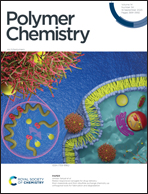A binary neodymium catalyst for the polymerization of lactones†
Abstract
Polylactones are widely used in biomedical applications and for drug delivery due to their biocompatibility and biodegradability. Polylactones are produced by the ring-opening polymerization (ROP) of the corresponding lactone monomers using various catalysts. Among other ROP techniques (anionic, cationic, and radical), coordination ROP is less sensitive to substituents in the monomer and exhibits living polymerization behavior. Tin(II) 2-ethylhexanoate (Sn(Oct)2) and aluminum isopropoxide (Al(O-i-Pr)3) are the common catalysts for coordination ROP of ε-caprolactone. Unfortunately, in the presence of ester linkages at the γ-position in ε-caprolactone monomers, Sn(Oct)2 and Al(O-i-Pr)3 may react to the ester group which is a major drawback in the polymerization. Herein, we demonstrate the ability of the NdCl3·3TEP/TIBA catalytic system (TEP = triethylphosphate, TIBA = triisobutylaluminum) to polymerize not only ε-caprolactone, but also γ-functionalized ε-caprolactone monomers with varying linkages at the γ-position of ε-caprolactone. In utilizing the NdCl3·3TEP/TIBA catalytic system we were able to make block copolymers of PVL-b-PCL (PVL = polyvalerolactone, PCL = polycaprolactone), PBrCL-b-PCL (PBrCL = poly(γ-bromo-ε-caprolactone) and the amphiphilic block copolymer, PMEEECL-b-PCL (PMEEECL = poly(γ-2-[2-(2-methoxyethoxy)ethoxy]ethoxy-ε-caprolactone)). The activation energy for the polymerization of ε-caprolactone with NdCl3·3TEP/TIBA catalytic system was determined to be 32.6 kJ mol−1.



 Please wait while we load your content...
Please wait while we load your content...